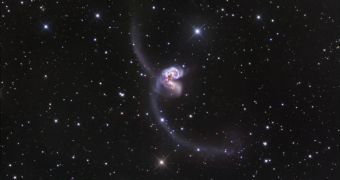The Antennae Galaxy is one of the closest and most studied galaxy mergers in the universe. It consists of two gravitationally interacting galaxies dubbed NGC 4038 and NGC 4039 that collided with one another a couple of hundred million years into the past. New observations made by researchers from the European Southern Observatory with the Hubble Advanced Camera for Surveys and the Wide Field Planetary Camera 2 revealed that in fact the past distance measurements to the Antennae Galaxies was overestimated by as much as 20 million light years.
Previous estimates showed that the Antennae Galaxies lie about 65 million light years away, while the new observations reveal that the distance is of only 45 million light years. The group of researchers conducting the study, led by Ivo Saviane, measured the light spectrum and brightness of red giant stars. The method is called the red giant branch and relies on the fact that red giants reach a certain standard brightness required for accurate distance measurements.
"All aspiring models for galaxy evolution must be able to match the observed features of the Antennae Galaxies, just as respectable stellar models must be able to match the observed properties of the Sun. Accurate models require the correct merger parameters, and of these, the distance is the most essential", says Saviane.
In some past models the Antennae Galaxies have been approximated to be more than 100 million light years away. This may seem a lot on the large scale, but some galaxies have been identified as far as more than ten billion years away, meaning that in fact the merger is relatively close to us. The larger distances would have also required astronomers to prove the existence of a high star formation ration, the presence of supermassive star clusters and powerful X-ray sources.
It is clear now that the Antennae Galaxies do not need to present any of these features to account for the observed phenomena. The infrared radiation coming from the merger on the other hand should be consistent with that of an early merger, as opposed to that of a galaxy experiencing ultra-luminous infrared radiation output. Additionally, the star cluster sizes now match those of other mergers.
The name of the galaxy comes from the appearance of the two long material trails created by the gravitational interactions, similar to those of the antennae of an insect. A collision between the Milky Way and the Andromeda galaxies in the next couple billion years could result in a similar merger.
Even though galaxy collisions are not as frequent today as they were in the early universe, they are considered to be an important step in the evolution of galaxies.

 14 DAY TRIAL //
14 DAY TRIAL //